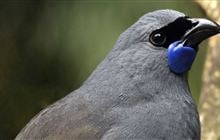Auckland trampers’ efforts boost kōkako numbers
Archived content: This media release was accurate on the date of publication.
Introduction
Two groups of enthusiastic Auckland trampers have become integral to the growth of the kōkako population in the North Island’s Pureora Forest.Date: 26 August 2020
For 10 years Auckland Tramping Club (ATC) and for 20 years Howick Tramping Club (HTC) have been contributing to pest control operations in the northern Pureora, helping to protect threatened native birds including the kōkako.
The kōkako is a forest songbird with an organ-like call, and is significant in Māori legend for helping Māui quench his thirst while he battled the sun.
In 1995 there was a remnant kōkako population of seven pairs in the northern Pureora/Rangitoto Ranges.
A four-yearly survey of kōkako was performed in May/June 2020 and results showed the northern Pureora is the first site nationally to have recovered to more than 1,000 individual birds. The Mangatutu and Tunawaea catchments have the highest density of kōkako on the mainland. Because of the robust numbers, 82 kōkako have been translocated from Mangatutu to support seven other projects.
Volunteers from the tramping clubs carpool to Pureora, usually visiting up to six times a year, leading up to and during the kōkako breeding season in spring and early summer to reduce predators through setting and baiting traps and maintaining bait stations.
HTC spokeswoman Colleen Grayling says between 20 and 25 volunteers regularly give their time and effort, staying for several nights at Rangitoto Station, owned by the Native Forest Restoration Trust.
HTC’s involvement with the kōkako efforts in Mangatutu goes back to 1997, and since 2003 the club has helped with applying for funding, purchasing supplies and administrative tasks to support DOC. ATC has been working in the Tunawaea catchment since 2011.
“The reasons we volunteer are using our outdoor skills and gear for a worthwhile cause, enjoying the bush and birdlife, a chance to hear and see kōkako and the camaraderie of being with like-minded people,” Colleen Grayling says.
Hearing the calls of the increasing kōkako population and seeing the positive survey results drives the involvement: “We have definitely had our challenges, but overall, our loyal volunteers’ hard work has paid dividends.”
The HTC has been supported by the Pukekohe Tramping Club and the Papatoetoe-based Toi Toi Trekkers and numerous individual volunteers since 2003.
Auckland Tramping Club’s Tony Walton says members began kōkako protection work in 2011, in the Tunawaea catchment– motivated by the same conservation goals as their Howick colleagues.
“We come to the Pureora Forest because it is an important area from where kōkako are translocated to other areas further north,” he says.
“Over the years the number of birds heard and seen has increased steadily - but we never dreamt this year that we were hosts to 80 pairs. It’s a great reward for the many days of work we do in the Tunawaea each year.
“Last year the founder of our kōkako project, Liz Ware, watched three juvenile kōkako playing around together on one of our tracks – definitely a first.”
Liz was invited to assist when 11 kōkako were translocated from the Tunawaea to the Waitakere Ranges in 2010, which proved to be the motivation for commencing the ATC work in Pureora.
DOC Maniapoto Community Ranger Kina Campbell says the two tramping clubs’ continued efforts demonstrate the importance of community contributions to conservation.
“It’s a testament to their passion for the outdoors and enthusiasm for protecting native species as the reason why they make the journey south to the Pureora.
“To see the steady growth in the kōkako population is a great reflection in the value of the work being put in by members of these two tramping clubs.”
DOC has ground-based predator control in Pureora to protect kokako and other native bird species.
As a result of the central North Island pest control work, the official status of the kōkako has moved from ‘Threatened’ to ‘At Risk – Recovering’ – a great result for all the years of dedicated work by so many people.
Contact
For media enquiries contact:
Email: media@doc.govt.nz


